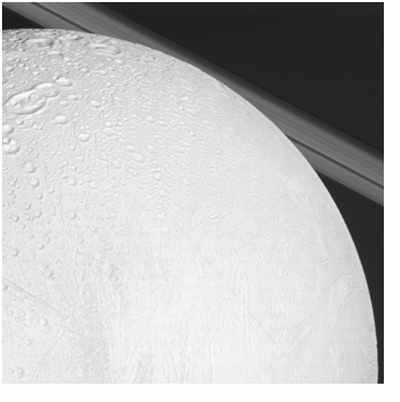14 February 2011

Credit: NASA/JPL/Space Science Institute
NASA recently published a wonderful image of Saturn’s bizarre, small moon, Enceladus. The image was acquired by the Saturn-orbiting Cassini spacecraft. It shows numerous craters and tectonically deformed terrain on Enceladus, and also captures Saturn’s magnificent rings, stretching diagonally, in the background, from the upper left corner to the right. The craters on Enceladus’ icy surface represent older, less evolved features.
The image was obtained with Cassini’s narrow angle camera, as the spacecraft flew by Enceladus (504 km across), at a distance of approximately 46,000 km, on 30 November 2010. Cassini was about 1 degree above the plane of the rings.
Enceladus is one of the most intriguing planetary moons. It is characterized by a rare type of volcanic activity, known as cryovolcanoes, or ice volcanoes. These amazing volcanoes spew cold material, rather than glowing incinerating lavas. In 2005, Cassini discovered large plumes of icy particles and cold vapors, emanating from fissures on Enceladus’ south polar region.
Saturn’s magnificent graceful rings are composed of small icy particles, ranging in size from dust grains to boulders. The brightest rings extend for several hundred thousand kilometers from the planet’s center, but a giant, very faint ring, over 24 million km in diameter, was discovered around in Saturn, applying infrared techniques, in 2009. The main rings are also very thin, compared to their breadth, as they are less than 1 km thick.
Enceladus orbits Saturn every 1.4 days, at a distance of approximately 238,000 km. For comparison, the Moon (3,476 km across), orbits Earth every 27.3 days, at an average distance of approximately 384,000 km. Interestingly, most of the moons of the Solar System have been named after characters of ancient mythologies. In Greek mythology, Enceladus was one of the Titans, led by his brother Cronus (Saturn).
The Cassini mission is one of the largest and most successful scientific projects. Its budget is over US$3bn. Cassini was launched toward Saturn (approximately 120,000 km across) on 15 October 1997, and entered orbit around Saturn (approximately 1.4 billion km distant) on 1 July 2004. It is expected that Cassini’s operation will continue till 2017.
References
NASA’s Photojournal
NASA’s Saturn Satellites Fact Sheet
Aymen Mohamed Ibrahem
Senior Astronomy Specialist